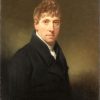Magnetic Personalities: Sebald Justinus Brugmans
Sometimes great discoveries find the scientist. This is certainly the case with Dutch botanist Sebald Justinus Brugmans. Through a complex life with many careers, Brugmans contributed to an array of scientific fields including chemistry, medicine, botany, and physics.
Born in 1763 in the Netherlands, Brugmans got his start in the scientific world while at university. Proving himself a true renaissance man, Brugmans studies included a potpourri of subjects including mathematics, philosophy, and medicine. Through his varied course load, Brugmans realized how interconnected various academic disciplines truly were. It was this notion that led to his doctoral studies regarding the correlations between chemistry and medicine.
Sebald Justinus Brugmans: The Doctor
After receiving his doctorate from the Dutch University of Groningen, Brugmans served as a faculty member at the University of Leiden. While his main area of research dealt with botany, a series of promotions saw Brugmans transitioning to the philosophy and medicine departments.
At this point, the Netherlands was becoming a haven for refugees fleeing the numerous conflicts across Europe. In 1794, along with other doctors and medical students, Brugmans established an emergency hospital on the outskirts of Leiden. This makeshift hospital sought to treat returning and retreating British and German soldiers. He established two more impromptu hospitals and gained the attention of the Dutch military.
Military Career
Following the success of his field hospitals, Brugmans was enlisted in the military and eventually rose to the rank of Inspector-General. He oversaw the entire Dutch navy, all veterinary responsibilities (the military used a lot of horses), and maintained healthy conditions in prisons, hospitals, and barracks.
Improving conditions across the Netherlands and its colonies became Brugmans’ chief work. It is perhaps for what he is most remembered. He was especially instrumental in containing gangrene throughout the military—a disease that plagued much of the world at the time.
Brugmans and Diamagnetism
While his studies in botany, philosophy, chemistry, and medicine, along with an extensive military and public service record are more than enough to earn Brugmans a page in the history books, we remember him for another reason.
Brugmans was conducting chemistry research at the Leiden in 1793. While working with the elements bismuth and antimony, he noted that the two metals repelled one another. Thus, the principle of diamagnetism was discovered! Unlike ferromagnetism or paramagnetism, wherein certain materials are attracted to one another, diamagnetic materials repel each other. In other words, materials that do not actively attract are diamagnetic.
British physicist Michael Faraday would later expound upon this discovery, going as far to assert that most materials are inherently diamagnetic. However, if it were not for the initial discovery by Sebald Justinus Brugmans, this truism of matter would have never been named in the first place!
The study of magnetism is constantly uncovering new discoveries and revelations. However, none of these advancements would be possible without the dedicated scientists curious enough to learn more. You can learn more about the men and women who have helped further our understanding of magnetism by checking out the rest of our Magnetic Personalities series, only on the Apex Magnets blog!

